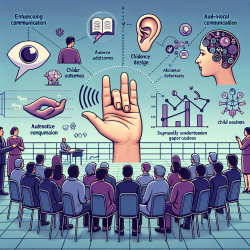Introduction
In the field of speech-language pathology, understanding how different communication modalities can be adapted for diverse audiences is crucial. A recent study titled Evidence of Audience Design in Amnesia: Adaptation in Gesture but Not Speech provides valuable insights into how gestures, even in individuals with amnesia, can be adapted to meet the needs of a child listener. This blog explores the findings of this study and discusses how practitioners can leverage these insights to improve communication outcomes for children.
Understanding the Study
The study examined the communication strategies of individuals with hippocampal amnesia when tasked with explaining everyday activities to both adult and child listeners. Interestingly, while these individuals did not modify their speech based on the listener's age, they did increase the use of representational gestures when addressing an imagined child listener. This suggests that gestures can serve as a significant communicative resource, even when verbal adaptation is impaired.
Key Findings
- Patients with amnesia produced more gestures for child listeners compared to adult listeners, despite no change in speech complexity or length.
- These gestures were often representational, providing visual context that complemented the verbal instructions.
- The gesture rates of patients with amnesia were comparable to those of neurotypical peers, indicating that gesture adaptation might be supported by different memory systems than speech.
Implications for Practitioners
For speech-language pathologists, these findings highlight the importance of incorporating gestures into therapeutic practices, especially when working with children or individuals with memory impairments. Here are some practical applications:
- Encourage Gesture Use: Promote the use of gestures in therapy sessions to enhance understanding and retention, particularly for children who might benefit from visual cues.
- Gesture Training: Develop training programs for children that focus on using gestures to support their verbal communication, which can be particularly beneficial for those with language delays or disorders.
- Monitor Gesture Adaptation: Observe how children adapt their gestures in different contexts and use this information to tailor interventions that support their unique communication needs.
Further Research
The study opens up several avenues for further research. Understanding the neural mechanisms that allow gesture adaptation in the absence of verbal adaptation can provide deeper insights into multimodal communication strategies. Additionally, exploring how these findings can be generalized to other populations with cognitive impairments could significantly enhance therapeutic approaches.
Conclusion
The ability to adapt communication strategies is essential for effective interaction, particularly with children. By leveraging the power of gestures, practitioners can create more engaging and comprehensible communication experiences. This study underscores the potential of gestures as a tool for enhancing communication, even in the presence of verbal limitations.
To read the original research paper, please follow this link: Evidence of Audience Design in Amnesia: Adaptation in Gesture but Not Speech.










